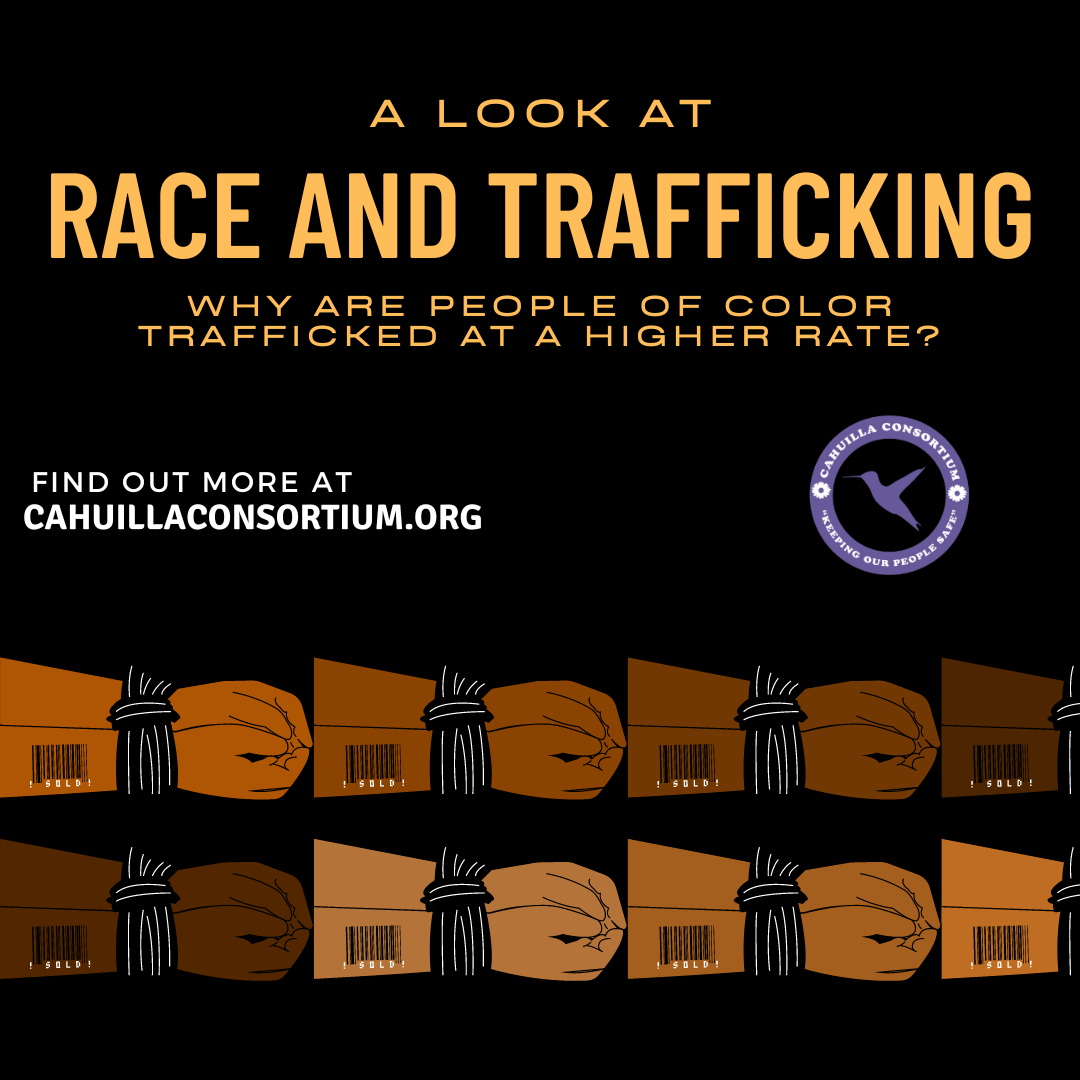A Look at Race and Trafficking

As most of us know, Human Trafficking, like other victimization types, disproportionately affects people of color at a higher rate. In this blog, we will examine why people of color are disproportionately victimized by sex and labor trafficking at higher rates. An important note: when discussing sex trafficking, this blog will focus on female victims of sex trafficking as very little statistical data is available surrounding male victims of sex trafficking. For the Cahuilla Consortium, the limited data in no way minimizes or invalidates the experiences of male victims and survivors of human trafficking.
When looking at sex trafficking, we found a report from the Bureau of Justice Affairs that shows that in cases where race was identified, approximately 40% of sex trafficking victims were identified in full or in part as Black. Another study from the Urban Institute dictated that most traffickers believed they would receive less jail time for trafficking women of color (specifically Black Women) than their white victims. Moreover, another report from the FBI shows that approximately 40% of sex trafficking victims they surveyed identified as full or part Native American. It is important to note that Black and Native American people each make up less than 15% of the population of this country.
Regarding Labor Trafficking, approximately 70% of the victims identified were confirmed to be undocumented persons from other countries. Of this percentage, people of Hispanic descent comprised about 65% of all victims, with Asian victims being the second largest population at 17%.
With such disproportionately high victimization rates among people of color, we must analyze why they are trafficked at higher rates. One of the main factors affecting people of color’s victimization rates is the promise of a more financially secure future. Often, pimps can lure young girls into trafficking with false promises of being provided for financially. This is especially appealing to many young Black and Native American women. Statistically, Native and Black Americans are the first and second racial groups most likely to experience poverty in the United States at 25% and 21%, respectively.
Additionally, our previous conversations surrounding the Missing and Murdered Indigenous Women Epidemic highlighted the many jurisdictional issues in place allowing young Native Women to be taken away from their families and Reservations. As with many conversations in the United States, racism also plays a role in the higher margin for women of color to be sex trafficked. Society often fetishizes women of color for their physical features, thus driving the profits for traffickers. Some community members also utilize race to justify why women are “in the life.” Often, outsiders believe that women of color who are victims of trafficking are addicted to sex or drugs. Both beliefs are common sex trafficking myths.
People of color who are victims of labor trafficking are often victimized at higher rates for different reasons compared to sex trafficking. As many of you might have guessed, immigration status often plays a huge role in a trafficker’s ability to keep control of a victim. Often, victims of labor trafficking are brought to the United States by their trafficker. Usually, upon arrival, traffickers keep their victims’ vital documents, such as passports, to reduce their ability to leave. They are often forced to work under the threat of their trafficker calling immigration authorities or harming their family in their home countries. At times, victims of labor trafficking are paid; however, they are paid significantly less than Federal/State minimum wage requirements. This requires trafficking victims to produce more work for their trafficker to afford basic necessities. Traffickers can sell their victims the dream of a better life in the United States to lure them.
As we all know, anyone can be a victim of human trafficking. However, specific populations are at higher risk of being victimized by traffickers. Like many other types of victimization, many systemic issues are in place, allowing minoritized communities to be victimized at higher rates. These systemic issues need to be changed to ensure people of color are no longer victimized at a higher rate and to eradicate human trafficking in our country.
References:
https://polarisproject.org/labor-trafficking-examples/
https://polarisproject.org/blog/2020/07/racial-disparities-covid-19-and-human-trafficking/
https://www.cbcfinc.org/wp-content/uploads/2020/05/SexTraffickingReport3.pdf